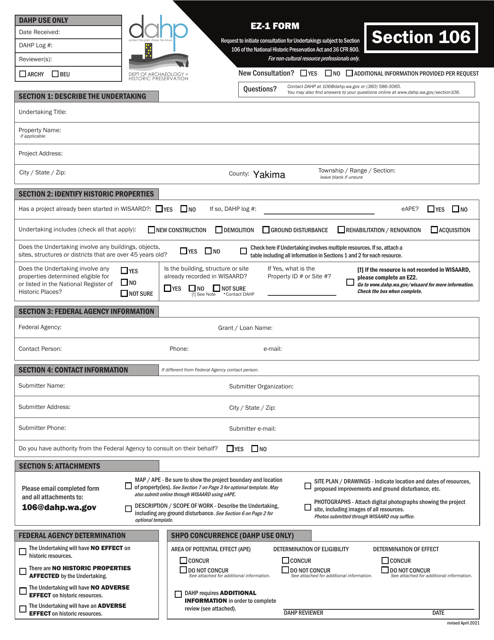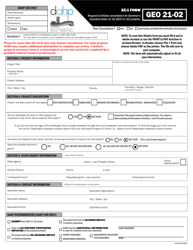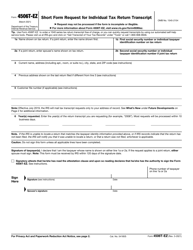Form EZ-1 Request to Initiate Consultation for Undertakings Subject to Section 106 of the National Historic Preservation Act and 36 Cfr 800 - Washington
What Is Form EZ-1?
This is a legal form that was released by the Washington State Department of Archaeology & Historic Preservation - a government authority operating within Washington. As of today, no separate filing guidelines for the form are provided by the issuing department.
FAQ
Q: What is the National Historic Preservation Act?
A: The National Historic Preservation Act is a federal law that aims to preserve and protect historic properties and resources in the United States.
Q: What is Section 106 of the National Historic Preservation Act?
A: Section 106 requires federal agencies to consider the effects of their undertakings on historic properties and engage in consultation with interested parties.
Q: What is an undertaking under Section 106?
A: An undertaking refers to any project or activity that is carried out, licensed, or funded by a federal agency.
Q: What is the purpose of Section 106 consultation?
A: The purpose of Section 106 consultation is to identify and evaluate the potential impacts of an undertaking on historic properties and to seek ways to avoid, minimize, or mitigate those impacts.
Q: Who participates in Section 106 consultation?
A: Key participants in Section 106 consultation include the federal agency, State Historic Preservation Office (SHPO), Tribal Historic Preservation Office (THPO), and other stakeholders with an interest in the project.
Q: How does the Section 106 consultation process work?
A: The Section 106 process involves four main steps: initiation, identification, assessment, and resolution of adverse effects. It requires coordination, information exchange, and public involvement.
Q: What is the role of the State Historic Preservation Office (SHPO)?
A: The SHPO plays a crucial role in the Section 106 process by reviewing and commenting on project documentation, identifying historic properties, and providing guidance on preservation strategies.
Q: What happens if adverse effects are identified?
A: If adverse effects are identified, the parties involved in the consultation process must work together to develop measures to avoid, minimize, or mitigate those effects.
Q: Can the public participate in Section 106 consultation?
A: Yes, the public is encouraged to participate in the Section 106 consultation process by providing input, attending meetings, and submitting comments on proposed projects.
Q: What happens after Section 106 consultation is completed?
A: After consultation is completed, the federal agency must make a final decision, taking into account the effects on historic properties and any agreed-upon measures to avoid, minimize, or mitigate adverse effects.
Form Details:
- Released on April 1, 2021;
- The latest edition provided by the Washington State Department of Archaeology & Historic Preservation;
- Easy to use and ready to print;
- Quick to customize;
- Compatible with most PDF-viewing applications;
- Fill out the form in our online filing application.
Download a fillable version of Form EZ-1 by clicking the link below or browse more documents and templates provided by the Washington State Department of Archaeology & Historic Preservation.









